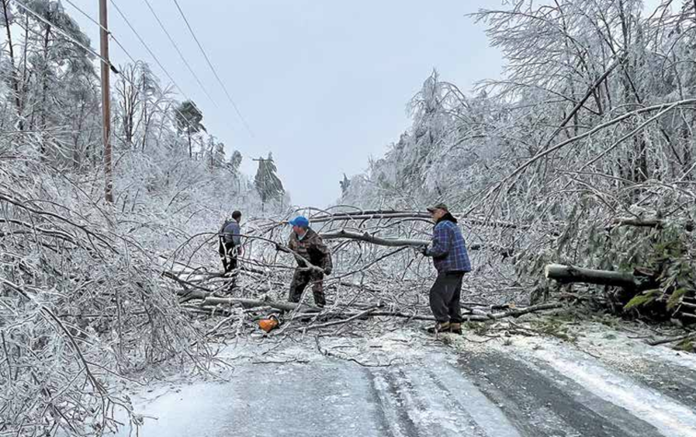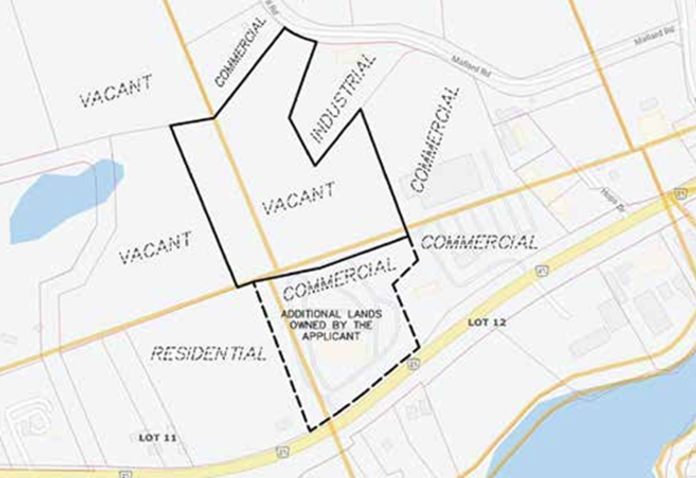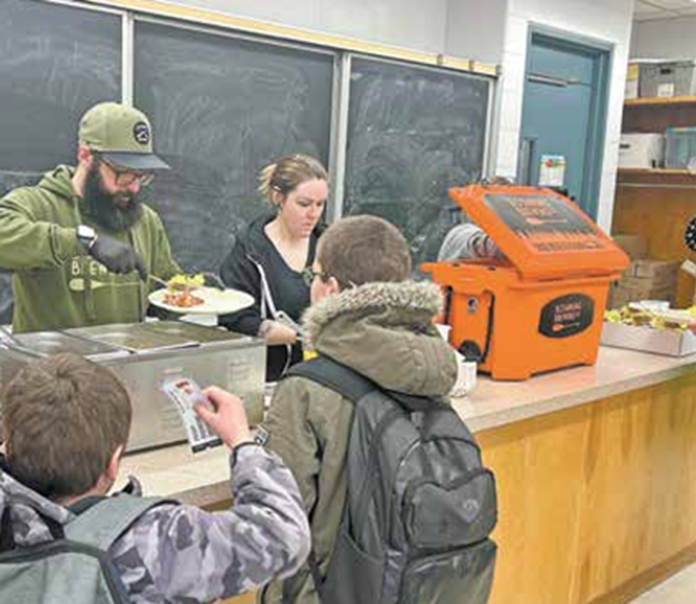Hydro One estimated more than 7,500 customers in Haliburton County were without power as of noon, April 2, as recovery from the weekend’s ice storm continues.
Work was underway at over 60 locations across the Highlands as of press time, with crews doing what they can to restore downed and damaged power lines, said Hydro One representative Tiziana Baccega Rose.
So far, approximately 820,000 customers across Ontario have had power restored, with 203,000 homes still in the dark. The company did not say when it would have power restored for most County residents, though its online outage map states most should be back online by April 3 at 11 p.m.
“After most storms, we typically see damage concentrated in specific areas. This storm has been widespread, with damage accumulating over several days. On some lines, crews have identified multiple types of damage that need to be addressed before power can be restored.
“Crews are focused on restoring the main lines that run from the local stations to the community. Then they will be able to focus on cleaning damage from lines that serve smaller groups of customers to get the power back on… we expect restoration in the hardest hit areas to continue throughout the week,” Rose told The Highlander.
She said Hydro One workers have been called in from other parts of the province to support areas most impacted, with local utility companies and contractors also assisting.
Thousands still without power
Rose said reconnection for residences in remote areas and for water-access only properties will take longer. She also warned that another storm system, beginning April 2, may result in further outages.
Municipal response
After Minden Hills declared a state of emergency March 31, mayor Bob Carter said the community is “suffering through unprecedented series of challenges.” Many people are also without cell and internet service, Carter said.
“Our staff and emergency control group have been working through the weekend… now supplemented by staff from the County of Haliburton, our neighbouring municipalities, Renfrew County, York Region, and the province,” Carter said.
S.G. Nesbitt Memorial Arena has been open 24 hours a day during the emergency, serving as a warming centre for those without power and an information hub for people looking for updates on cleanup and restoration efforts. There are shower facilities available, as well as spots for charging devices. Pets are not permitted at the arena.
A mobile virtual triage and assessment centre has been set up at the arena. Paramedics will be available to treat health concerns 24/7, no appointment needed.
Carter said all other municipal facilities are temporarily closed. While landfill sites remain open for regular winter hours – as with all across the County – most locations are cash-only.
Dysart et al mayor Murray Fearrey said Haliburton village was largely unscathed.
“Fortunately, we got a couple inches of snow before the rain and it certainly reduced the impact. We have had several power outages, most are coming back on. We do have some trees down but issues we can deal with. Nothing compared to what I’m seeing in Minden and Algonquin Highlands,” Fearrey said.
He said the township hadn’t established any warming stations in the community, noting “[we] haven’t had any requests or need that I have been aware of, or staff.”
Dysart town hall reopened April 1. The township has also ended the significant weather event it declared alongside the County and other three lower-tier townships March 28.
Algonquin Highlands opted to extend its warning until April 4, given the threat of more freezing rain this week. The township office on North Shore Road will remain open to the public during regular operating hours, with the Dorset Recreation Centre also open.
Deputy mayor Jen Dailloux, said residents endured “treacherous conditions” over the weekend.
“There were intermittent power outages, and a couple of localized outages continue as branches get cleared off lines. But the greatest impact was the partial communications blackout, which affected the southern half of the township.” Dailloux said.
She noted the township deployed public works staff to Minden Hills to assist with storm clean-up. Highlands East municipal office in Wilberforce was closed March 28 to April 1, but reopened April 2.
Other closures
All Trillium Lakelands District School Board (TLDSB) schools, including those in the County, have been shuttered since Monday.
“Some areas within TLDSB are still without power and are dealing with the aftermath of the storm, such as power and internet outages, downed trees and hazardous conditions. In addition, there are freezing rain warnings [Wednesday] morning. In the interest of student and staff safety, we have made the decision to keep schools and childcare centres within schools closed,” said communications lead Carolynne Bull. “Schools will not be moving to online learning.”
The Haliburton School of Art + Design was also closed March 31 and April 1.
Haliburton Highlands Health Services (HHHS) is under a Communications Code Grey, with all telephone, IT and internet services offline. The emergency department in Haliburton remains open, with the Urgent Care Clinic in Minden reopening Wednesday with regular hours, after closing March 31 and April 1. LifeLabs also reopened Wednesday.
HHHS’ community support services will be interrupted, including adult day program, meals on wheels and transportation. For those in-need, meals can be picked up in Haliburton between 8:30 a.m. and 4:30 p.m. this week.
Highland Wood and Hyland Crest longterm care facilities remain open to visitors. Staff noted phone lines at the centres remain down as of press time.
Most businesses have reopened in Haliburton and Minden, though are cash only.
Mary Douglas, owner of Let’s Get Local in Minden, said, “it’s been a rough go for everyone, that’s for sure. Lessons learned – always have some cash on hand. We’re cash-only while systems are offline.”
Pitching in
Cheryl Smith Hamilton was trying to get down Deep Bay Road in Minden on Sunday to check in with her parents, who live on the road, but found it impassable due to downed trees. After confirming they were OK, Smith Hamilton said rather than wait for municipal staff or hydro workers to clear the route, her family got to work.
Larry and Donelda Smith, Kirk Smith, Smith Hamilton, and Mike Hamilton spent hours trimming branches buckling under the weight of ice build-up and clearing limbs that were blocking the road.
“As we were clearing, other travellers would join in to pull debris off the road. About midpoint down Deep Bay, we were met by another individual who had been clearing it from Hwy. 35-way up,” she told The Highlander.
She posted a video to her social media March 30 showing the damage, which was shared almost 900 times. An update on April 2 showed the road back to normal, with Smith Hamilton adding, “so thankful that I live in a smalltown where locals and visitors never hesitate to jump in and help out anyone in need… it truly takes a village.”
North Shore Road resident Paul MacInnes said he had power earlier this week when many of his friends and neighbours didn’t. So, he and his wife, Susan, opened up their home. They offered people a hot shower and home-cooked meal.
“You do what you can in situations like this. That’s what community is all about,” MacInnes said.











